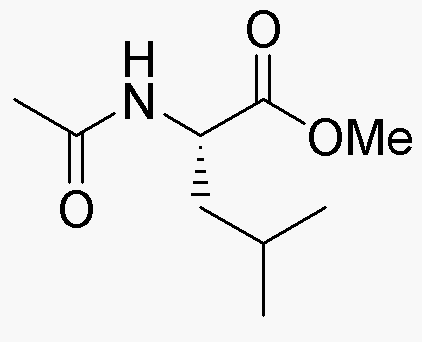Acetyl-L-leucine methyl ester is widely utilized in research focused on:
- Pharmaceutical Development: This compound serves as a valuable intermediate in the synthesis of pharmaceuticals, particularly in the development of drugs targeting neurological disorders.
- Protein Synthesis Studies: It is used to study protein synthesis and metabolism, providing insights into amino acid utilization and its effects on muscle growth.
- Cosmetic Formulations: The compound is incorporated into skincare products for its moisturizing properties, enhancing skin hydration and texture.
- Biochemical Research: Researchers utilize it to investigate metabolic pathways and enzyme activity, contributing to a better understanding of cellular processes.
- Food Industry Applications: It is explored as a flavoring agent or additive, enhancing the taste profile of various food products while maintaining safety and quality.
General Information
Properties
Safety and Regulations
Applications
Acetyl-L-leucine methyl ester is widely utilized in research focused on:
- Pharmaceutical Development: This compound serves as a valuable intermediate in the synthesis of pharmaceuticals, particularly in the development of drugs targeting neurological disorders.
- Protein Synthesis Studies: It is used to study protein synthesis and metabolism, providing insights into amino acid utilization and its effects on muscle growth.
- Cosmetic Formulations: The compound is incorporated into skincare products for its moisturizing properties, enhancing skin hydration and texture.
- Biochemical Research: Researchers utilize it to investigate metabolic pathways and enzyme activity, contributing to a better understanding of cellular processes.
- Food Industry Applications: It is explored as a flavoring agent or additive, enhancing the taste profile of various food products while maintaining safety and quality.
Documents
Safety Data Sheets (SDS)
The SDS provides comprehensive safety information on handling, storage, and disposal of the product.
Product Specification (PS)
The PS provides a comprehensive breakdown of the product’s properties, including chemical composition, physical state, purity, and storage requirements. It also details acceptable quality ranges and the product's intended applications.
Certificates of Analysis (COA)
Search for Certificates of Analysis (COA) by entering the products Lot Number. Lot and Batch Numbers can be found on a product’s label following the words ‘Lot’ or ‘Batch’.
*Catalog Number
*Lot Number
Certificates Of Origin (COO)
This COO confirms the country where the product was manufactured, and also details the materials and components used in it and whether it is derived from natural, synthetic, or other specific sources. This certificate may be required for customs, trade, and regulatory compliance.
*Catalog Number
*Lot Number
Safety Data Sheets (SDS)
The SDS provides comprehensive safety information on handling, storage, and disposal of the product.
DownloadProduct Specification (PS)
The PS provides a comprehensive breakdown of the product’s properties, including chemical composition, physical state, purity, and storage requirements. It also details acceptable quality ranges and the product's intended applications.
DownloadCertificates of Analysis (COA)
Search for Certificates of Analysis (COA) by entering the products Lot Number. Lot and Batch Numbers can be found on a product’s label following the words ‘Lot’ or ‘Batch’.
*Catalog Number
*Lot Number
Certificates Of Origin (COO)
This COO confirms the country where the product was manufactured, and also details the materials and components used in it and whether it is derived from natural, synthetic, or other specific sources. This certificate may be required for customs, trade, and regulatory compliance.


